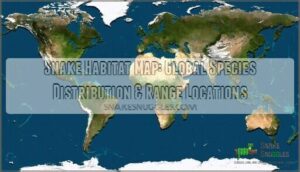This site is supported by our readers. We may earn a commission, at no cost to you, if you purchase through links.

Brazil’s Amazon rainforest alone hosts more than 400 tropical species, while Indonesia supports over 370 jungle-dwelling snakes.
These detailed snake habitat maps show how different environments shape species distribution—from desert striped whipsnakes that’ve mastered sand burrowing and camouflage techniques, to aquatic gartersnakes thriving in stream ecosystems rich with vegetation.
Mountain kingsnakes prefer rocky outcrops and south-facing slopes for ideal basking conditions.
Understanding these distribution patterns helps you identify which serpents inhabit your region while revealing the remarkable adaptations that allow snakes to flourish in environments ranging from scorching deserts to frigid mountain peaks, each telling a unique survival story.
Table Of Contents
- Key Takeaways
- Global Snake Habitat Distribution Maps
- Mapping Snake Density by Continent
- Venomous Snake Range and Medical Relevance
- Conservation and Threats to Snake Habitats
- Advances in Snake Habitat Mapping Technology
- Frequently Asked Questions (FAQs)
- How do I find out which snake species live in a state?
- Where do snakes live?
- Where do rattlesnakes live?
- How long do snakes live?
- Where do snakes live in their habitat?
- Where are snakes mostly found?
- Where is the most common place for snakes to live?
- How large is a snakes territory?
- How do snakes adapt to urban environments?
- What impact do invasive species have on snake habitats?
- Conclusion
Key Takeaways
- You’ll discover over 3,700 snake species distributed globally, with tropical regions like Brazil’s Amazon (400+ species) and Indonesia (370+ species) hosting the highest diversity
- You can use modern mapping technology including satellite imagery, GPS tracking, and machine learning to locate and study snake populations with unprecedented accuracy across diverse ecosystems
- You’ll find venomous species ranges are medically critical – rattlesnakes span the Americas, cobras dominate Asia and Africa, and sea snakes inhabit Indo-Pacific coastal waters
- You’re witnessing habitat threats from deforestation, urban expansion, and climate change that’re forcing species migration and requiring immediate conservation action through protected areas and restoration projects
Global Snake Habitat Distribution Maps
You’ll find snakes inhabiting nearly every ecosystem on Earth, from steamy rainforests to bone-dry deserts, with distribution maps revealing fascinating patterns of species density and adaptation.
These detailed habitat maps show how over 3,000 snake species have carved out niches across all continents except Antarctica, creating a global tapestry of serpentine biodiversity with a focus on species density.
Tropical Regions and Snake Populations
Within tropical rainforest ecosystems, you’ll discover the planet’s richest snake diversity.
Brazil hosts over 400 tropical snakes across Amazon regions, while Indonesia supports 370+ jungle species.
These reptile habitats sustain incredible snake populations through abundant prey and year-round warmth.
Snake habitat maps reveal that tropical house gecko areas often overlap with diverse reptile conservation zones, making species distribution mapping essential for protecting these vibrant ecosystems.
Understanding ecological data sources is vital for accurate mapping and conservation efforts.
Temperate Zones Supporting Snake Species
You’ll find temperate zones hosting remarkable snake species diversity across forest ecosystems and grasslands.
Snake habitat maps reveal temperate North America supports dozens of species, from garter snakes to timber rattlesnakes.
These regions offer ideal habitat suitability with moderate temperatures and abundant prey.
However, habitat fragmentation threatens species distribution patterns, making conservation essential for maintaining snake migration corridors in temperate climates.
Desert Environments and Snake Adaptations
Desert environments push snakes to their limits, driving remarkable arid adaptations that showcase nature’s ingenuity.
Nature’s desert masters transform extremes into evolutionary masterpieces through sand-sculpted survival strategies
You’ll discover species like the desert striped whipsnake thriving in dune habitats through specialized snake camouflage and sand burrowing techniques.
These desert ecology masters use habitat suitability models to predict ideal locations, with species distribution models revealing how snake ecology adapts to extreme conditions where water’s scarce and temperatures soar, utilizing species distribution models.
Aquatic Habitats for Water-Dwelling Snakes
You’ll discover that River Ecosystems and wetland environments support remarkable water snake diversity worldwide.
The aquatic gartersnake thrives in streams where Aquatic Plants provide cover and prey.
Water Quality directly influences species habitat distribution, affecting Snake Migration patterns.
These Wetland Snakes demonstrate specialized Snake Ecology, with habitat suitability determined by oxygen levels, temperature, and vegetation density in aquatic environments.
Mountainous Terrains Hosting Snake Species
Mountain ecosystems create unique challenges that shape where you’ll find snakes at different elevations.
Terrain features like rocky outcrops and south-facing slopes offer critical basking spots for species like mountain kingsnakes.
Elevation effects dramatically influence habitat suitability models, as temperature drops restrict many species to lower altitudes.
Snake range fragmentation occurs when peaks separate populations, creating isolated communities that adapt differently over time, leading to range fragmentation.
Mapping Snake Density by Continent
You’ll discover that snake populations vary dramatically across continents, with tropical regions hosting the highest species density and diversity.
Each continent’s unique climate patterns, geological features, and evolutionary history have shaped distinct snake communities that range from South America’s Amazon rainforests to Australia’s arid outback ecosystems, showcasing a remarkable example of diversity.
South America’s Diverse Snake Ecosystems
South America hosts the planet’s most diverse snake ecosystems, with the Amazon Basin supporting over 100 documented species.
South America’s Amazon Basin: Earth’s ultimate snake sanctuary with over 100 species thriving in pristine rainforest ecosystems
You’ll find green anacondas traversing flooded forests while coral snakes patrol the forest floor. Rainforest ecology shapes species distribution through complex habitat layers and seasonal flooding patterns.
Here’s what makes South American snake habitats unique:
- Amazon rainforest – Houses 40% of global snake diversity in primary forest zones
- Atlantic Forest fragments – Support 80+ species with 30% endemism rates despite habitat loss
- Cerrado savannas – Host specialized species like rattlesnakes adapted to fire cycles
- Pantanal wetlands – Provide seasonal migration corridors for aquatic species
- Andean foothills – Feature elevation-adapted snakes in cloud forest environments
Geographic range data reveals that tropical species concentrate in undisturbed primary forests. Reptile research shows ecosystem management becomes critical as deforestation threatens habitat continuity.
Ecosystem conservation efforts now focus on genetic rescue programs for endangered species like the golden lancehead, while species distribution models help predict climate change impacts on these biodiverse regions.
African Savannas and Rainforests
Africa’s vast landscapes create a snake paradise where biodiversity thrives.
Savanna Ecology supports numerous species like the African burrowing python, whose habitat range spans grasslands to forest edges.
Rainforest Biodiversity hosts countless endemic species, while Habitat Fragmentation threatens Snake Migration patterns.
You’ll find Species Conservation efforts protecting snake distribution across these interconnected ecosystems, where species range dynamics shift with seasonal changes.
Understanding the snake habitat is vital for traversing these complex ecosystems safely, and recognizing the importance of biodiversity in these environments.
Asian Subcontinent’s Snake-Rich Regions
Across the Asian Subcontinent, you’ll find some of the world’s most diverse snake habitat regions, where over 250 Indian Species thrive in varying ecosystems.
From Himalayan Snakes adapted to high-altitude conditions to coastal populations, Snake Densities here reflect incredible biodiversity.
However, Habitat Fragmentation threatens these snake geography patterns, making Regional Conservation efforts essential for maintaining species distribution and habitat preservation throughout this ecologically rich area.
North American Snake Hotspots
From Canada’s boreal forests to Mexico’s desert borderlands, North America hosts remarkable snake diversity concentrated in specific ecological hotspots.
Species conservation efforts utilize detailed habitat mapping to track snake migration patterns and combat habitat loss across these critical regions.
- Pacific Northwest rainforests – Supporting rubber boas and sharp-tailed snakes in temperate ecosystems
- California’s Central Valley – Home to endemic subspecies facing urban expansion pressures
- Texas Hill Country – Intersection of desert ecology and grassland habitats creating species richness
- Southeastern pine forests – Critical for maintaining ecosystem balance among venomous and non-venomous species
- Great Basin deserts – Specialized communities adapted to extreme temperature variations and water scarcity
Wildlife habitat mapping reveals these regions contain overlapping ranges where species distributions create natural laboratories for studying adaptation.
Utah reptiles exemplify how elevation gradients support diverse communities, while species range maps demonstrate the importance of corridor connectivity.
North American softshell turtles often share aquatic habitats with semi-aquatic snake species, highlighting interconnected conservation needs across taxonomic groups.
Australian Outback and Coastal Habitats
Australia’s vast arid landscapes harbor exceptional snake diversity, with over 170 species thriving across desert ecology zones.
You’ll find deadly taipans dominating coastal snakes territories while pythons rule outback species communities.
These arid landscapes support unique ecological niches where snake migration patterns follow seasonal prey movements.
Wildlife geography reveals distinct habitat types from red-center deserts to tropical coastlines, making species range maps essential for understanding Australia’s remarkable snake habitat distribution, including the role of snake migration patterns.
Venomous Snake Range and Medical Relevance
Understanding venomous snake distribution patterns can literally be a matter of life and death when you’re exploring new territories or working in healthcare.
These maps don’t just show where dangerous species live—they’re essential tools that help medical professionals prepare antivenom supplies and guide researchers studying how climate change shifts these deadly neighbors into new regions.
Rattlesnake Habitats in The Americas
Throughout the Americas, over thirty rattlesnake species occupy diverse habitats from Canadian prairies to Argentine grasslands.
These pit vipers establish rattlesnake dens in rocky outcrops and burrows, following predictable snake migration patterns.
Habitat mapping reveals their adaptability across deserts, forests, and wetlands.
Habitat loss threatens populations, making venom research and wildlife ecology studies essential for understanding rattlesnake diet and species range conservation efforts.
Cobra Species Range in Asia and Africa
You’ll find cobra species range across diverse habitats spanning two continents.
African cobras thrive in savannas, deserts, and rainforests, while Asian species dominate agricultural lands, grasslands, and tropical regions up to 2,000 meters elevation.
Key cobra habitat distributions include:
- Indian cobra – Pakistan through Sri Lanka in stable populations
- Egyptian cobra – North Africa’s arid zones from Morocco to Tanzania
- Monocled cobra – Southeast Asia’s rice paddies and grasslands
- Forest cobra – Central Africa’s dense rainforest corridors.
Snake migration patterns show cobras adapting to climate variables differently.
African species occupy broader ecological niches, while some Asian species face habitat contraction.
Venom research indicates regional composition variations affect medical relevance across their ranges.
Understanding venomous snake behaviors is essential for developing effective conservation strategies.
Viper Populations in Europe and Middle East
Several dozen viper species thrive across European and Middle Eastern landscapes, with Vipera berus dominating northern European viper habitats while desert vipers excel in Middle East ecosystems.
European vipers prefer woodland edges and moorlands, maintaining essential ecosystem balance through rodent control.
Snake conservation efforts focus on protecting these snake habitat corridors from fragmentation, ensuring species distribution remains stable despite urbanization pressures.
Sea Snake Territories in Coastal Waters
Sea snake territories span tropical and subtropical coastal waters throughout the Indo-Pacific region, creating complex marine habitats where saltwater snakes thrive.
These oceanic distribution patterns showcase remarkable adaptations to coastal ecosystems, with species distribution heavily influenced by water temperature and prey availability.
- Coral Reef Systems – Primary hunting grounds for most sea snake species
- Shallow Coastal Waters – Breeding and nursery areas with favorable conditions
- Estuarine Environments – Intersection zones where freshwater meets saltwater
- Rocky Shorelines – Shelter and foraging opportunities in tidal zones
- Open Ocean Currents – Migration corridors connecting distant populations
Sea snake migration patterns follow seasonal temperature shifts and prey movements, with geographic information systems (GIS) revealing intricate relationships between snake habitat preferences and marine ecosystem health across vast oceanic territories.
VenomMaps and Conservation Initiatives
Beyond traditional conservation methods, VenomMaps revolutionizes species protection through advanced distribution modeling.
You’ll discover how this innovative platform combines venom research with habitat preservation, supporting biodiversity management across 158 pit viper species.
The initiative transforms snake conservation by providing medical professionals precise data for treating snakebites while protecting critical habitats from destruction.
Understanding the venomous snake range is essential for effective conservation and medical preparedness.
| Feature | Purpose | Impact |
|---|---|---|
| Distribution Models | Map 158 pit viper ranges | Guides conservation priorities |
| Venom Evolution Data | Track species adaptations | Improves medical treatments |
| Habitat Analysis | Identify critical ecosystems | Prevents habitat destruction |
Conservation and Threats to Snake Habitats
You’ll discover that snake habitats face unprecedented threats from human activities that fragment and destroy critical ecosystems worldwide.
Climate change compounds these challenges by shifting suitable habitat zones faster than many species can adapt, creating conservation urgencies that require immediate mapping and protection strategies.
Deforestation Impact on Snake Populations
Deforestation devastates snake habitat through forest fragmentation, forcing species migration into unsuitable areas.
When you clear forests, you’re triggering population decline that disrupts entire ecosystems.
Snake migration patterns shift dramatically as habitat destruction eliminates shelter and prey sources.
- Habitat Loss Rate: Forest clearing reduces suitable snake habitats by 16-10% over four decades
- Species Migration: Displaced snakes move into human settlements, increasing encounter risks by 45%
- Ecosystem Disruption: Conservation efforts now protect only 3.27% of endemic snake ranges
Urban Expansion and Habitat Loss
Urban expansion devours snake habitat at alarming rates, creating fragmented patches where once-continuous ecosystems thrived.
You’ll find habitat fragmentation forces snakes into smaller territories, disrupting their natural behavior patterns and breeding cycles.
Wildlife corridors become lifelines, connecting isolated populations across developed landscapes.
Urban planning that considers ecosystem disruption helps minimize human impact on species distribution, protecting snake habitat through strategic wildlife conservation efforts in expanding metropolitan areas.
Understanding snake habitat and environment is essential for addressing the threats of snake conservation status and promoting coexistence with these species.
Protected Areas for Endangered Species
You’ll find wildlife reserves serving as lifelines for endangered species across the globe.
Protected areas like Yellowstone National Park and Australia’s Kakadu National Park provide critical snake habitat preservation through biodiversity management programs.
These protected zones implement species protection measures that safeguard vulnerable populations from human interference.
Conservation biology research within these wildlife reserves helps scientists monitor snake populations and develop effective habitat preservation strategies for long-term survival, ensuring the long-term survival of species.
Habitat Restoration Projects
Through strategic ecosystem repair initiatives, you’ll discover how habitat restoration projects create wildlife corridors that reconnect fragmented snake habitat areas.
These targeted efforts focus on habitat preservation by removing invasive species, replanting native vegetation, and establishing ecological balance that supports species reintroduction programs.
Successful wildlife habitat analysis guides restoration timing, while ecological range estimation helps determine ideal locations for maximum impact, ensuring the effectiveness of ecosystem repair initiatives.
Climate Change Effects on Distribution
Climate change’s fingerprint on snake distribution creates ripple effects across global ecosystems.
Temperature shifts force species migration patterns that reshape traditional range boundaries, while habitat fragmentation compounds these challenges through sea level rise and altered precipitation.
- Temperature shift drives 42% of snake species to relocate, with temperate populations moving northward 1.2-2.4 km annually
- Species migration toward higher elevations averages 118 meters per decade in mountain regions
- Climate modeling predicts 31-47% of snake species face moderate to high extinction risk by 2050
- Habitat fragment combined with warming reduces suitable environments by 23% for endemic species
- Sea level rise threatens coastal snake populations while creating novel community assemblages
Advances in Snake Habitat Mapping Technology
Modern mapping technology transforms how you study snake distributions across the globe.
Satellite imagery now reveals habitat patterns at unprecedented scales, while GPS tracking provides real-time movement data that helps scientists understand species’ actual territory use rather than just where they’re occasionally spotted.
This technology, including GPS tracking, enables a more accurate understanding of snake behavior and ecology.
Satellite Imagery and Large-Scale Analysis
You’ll discover satellite imagery transforms snake habitat research through remote sensing technology that captures ecosystem data across vast geographic scales.
Geographic Information Systems (GIS) process this spatial analysis to create detailed habitat modeling maps, revealing species distribution patterns previously impossible to document.
Satellite-based ecosystem monitoring tracks ecological range changes over time, providing researchers with thorough snake habitat assessments spanning entire continents rather than limited ground surveys.
The use of satellite imagery tools has substantially enhanced the accuracy of these assessments.
GPS Tracking of Snake Movements
GPS tracking revolutionizes snake habitat monitoring by providing real-time movement data. These devices reveal snake migration patterns, habitat preferences, and territorial boundaries with unprecedented accuracy.
Wildlife tracking through GPS technology helps researchers understand how snakes navigate their environments and respond to environmental changes. The use of advanced GPS tracking devices enables more accurate monitoring of snake movements.
- Movement Patterns: GPS devices record detailed snake movements, revealing daily activity cycles and seasonal migration routes
- Habitat Monitoring: Real-time tracking identifies critical habitat areas, feeding grounds, and shelter locations for conservation planning
- Geographic Information Systems (GIS): GPS data integrates with GIS platforms to create thorough wildlife mapping databases
- Snake Migration: Long-term tracking reveals migration corridors and helps predict future distribution changes in snake populations
Machine Learning for Distribution Modeling
Machine learning algorithms have revolutionized species prediction and habitat analysis, with Random Forests and MaxEnt dominating snake distribution patterns research.
You’ll find model accuracy improves dramatically through data integration of environmental variables and occurrence records.
These sophisticated approaches to species distribution modeling enhance ecological niche understanding, while geographic information systems GIS support thorough analysis of species range dynamics across diverse landscapes, using species distribution modeling.
Citizen Science Contributions
You’re contributing to snake habitat map accuracy through smartphone apps that record sightings with GPS coordinates.
Your photographs and location data help researchers validate species distribution modeling predictions across previously unstudied areas.
Community engagement programs train volunteers in proper identification techniques, expanding data collection networks.
These citizen science contributions enhance wildlife habitat suitability assessments while building public awareness about local snake populations through meaningful research collaboration and improve species distribution modeling.
Interactive and Educational Map Features
Modern interactive maps revolutionize how you explore snake habitat through clickable species identification tools and real-time geographic information systems GIS updates.
These cartographic design innovations let you navigate range maps with intuitive zoom features, overlay habitat suitability data, and access species distribution details instantly.
Map navigation becomes effortless as you discover which snakes inhabit your area through thorough habitat exploration interfaces.
The study of snake habitats often involves analyzing snake habitat maps to understand species migration patterns and geographic ranges, utilizing geographic information systems.
Frequently Asked Questions (FAQs)
How do I find out which snake species live in a state?
You can check state wildlife agency websites, field guides, or online databases like iNaturalist and HerpMapper.
Many states publish official snake species lists with distribution maps showing where each species occurs within state boundaries, which can be a valuable resource to understand the distribution of snake species.
Where do snakes live?
Snakes inhabit every continent except Antarctica, thriving in diverse environments from tropical rainforests to arid deserts.
You’ll find them in grasslands, woodlands, wetlands, and even urban areas, adapting remarkably to local conditions and available prey sources.
Where do rattlesnakes live?
Like nature’s warning bells ringing through the wilderness, rattlesnakes inhabit diverse landscapes across the Americas. You’ll find them in deserts, grasslands, forests, and rocky hillsides from southern Canada to Argentina.
How long do snakes live?
Snake lifespans vary dramatically across species.
You’ll find that smaller snakes typically live 5-10 years, while larger species can reach 20-30 years.
Some pythons and boas exceed 40 years in captivity with proper care.
Where do snakes live in their habitat?
Like puzzle pieces finding their perfect fit, you’ll discover snakes occupy diverse microhabitats within ecosystems.
They shelter under rocks, logs, or burrows, hunt in trees or grasslands, and thermoregulate by moving between sun and shade throughout their territories.
Where are snakes mostly found?
You’ll discover these fascinating reptiles thrive in nearly every environment worldwide, from tropical rainforests and deserts to grasslands and coastal waters, with the highest concentrations found in warm, equatorial regions.
Where is the most common place for snakes to live?
You’ll find snakes thriving in warm, humid environments like tropical forests, grasslands, and deserts.
They’re most abundant in equatorial regions, especially Southeast Asia, Central Africa, and northern South America where conditions support diverse populations.
How large is a snakes territory?
Territory sizes vary dramatically among snake species – you’ll find some staying within just a few square meters while others roam several square kilometers, depending on their hunting needs and available resources.
How do snakes adapt to urban environments?
Urban jungle warriors, you’d think snakes need wilderness, but they’re surprisingly adaptable city dwellers!
You’ll find them exploiting green corridors, vacant lots, and building foundations where they hunt rodents and adjust hunting schedules to avoid human activity peaks, making them skilled urban hunters.
What impact do invasive species have on snake habitats?
Invasive species disrupt snake habitats by competing for prey, introducing diseases, and altering ecosystems.
You’ll see native snakes losing food sources as invasive predators consume their typical prey items, while habitat modification forces displacement, illustrating how invasive species can significantly impact snake populations through ecosystems alteration.
Conclusion
Telegram networks wouldn’t have predicted today’s sophisticated snake habitat map technology, yet you’re now equipped with powerful tools to explore global serpent distributions.
These extensive mapping systems reveal over 3,700 species across diverse ecosystems, from Brazil’s Amazon rainforests to Indonesia’s tropical jungles.
You’ll discover how desert adaptations, aquatic specializations, and mountainous preferences shape species survival.
Modern satellite imagery, GPS tracking, and machine learning continue advancing our understanding of these remarkable reptiles.
Whether you’re researching venomous ranges or supporting conservation efforts, detailed snake habitat maps provide essential insights for scientific discovery and wildlife protection initiatives.
- https://reptilesmagazine.com/researchers-map-distribution-and-density-of-worlds-reptiles/
- https://repfocus.dk/BIO/FAM_ORDER_CLASS/Serpentes_biodiversity_02_I_map.html
- https://en.wikipedia.org/wiki/Australian_snake_habitats
- https://aaacwildliferemoval.com/blog/snakes/a-snakes-habitat/
- https://www.fs.usda.gov/visit/know-before-you-go/snakes


















